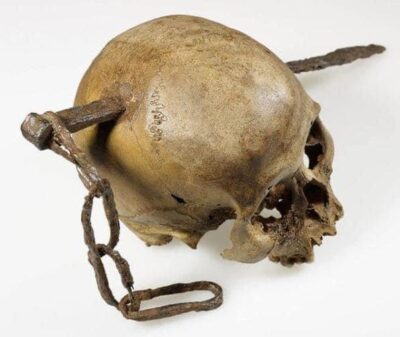Archaeologists working at Pompeii say they have found the remains of a man who survived the initial explosion of Mount Vesuvius in A.D. 79 — but was crushed by a massive rock as he attempted to flee a deadly cloud of gases, ash and rock.
The skeleton’s remains are in what the Pompeii archaeological site calls a “dramatic position” — with a large rectangular stone embedded in the upper torso.

“Initial observations would appear to indicate that the individual survived the first eruptive phase of the volcano, and subsequently sought salvation along the alley now covered in a thick layer of lapilli,” or rocks ejected by the volcano, the site said in a statement released Tuesday.
The man was on top of the layer of rocks, which was a full story high by that point. The dense cloud of gas and stone, called a pyroclastic flow, knocked him backward, the archaeologists say.
“A formidable stone block (perhaps a door jamb), violently thrown by the volcanic cloud, collided with his upper body, crushing the highest part of the thorax,” they explain.

The skeleton’s head has not been located, but archaeologists believe it is probably crushed beneath the stone block.
The man was an adult, over 30 years old, who had a bone infection that would have caused him to have trouble walking and may have interfered with his escape, archaeologists say.
Of course, plenty of able-bodied adults were equally caught up in the volcano’s deadly cloud.
The massive explosion of Vesuvius, which destroyed Pompeii and Herculaneum, is one of history’s best-known natural disasters. The human toll was detailed by Pliny the Younger, who described an apocalyptic scene of profound tragedy, and preserved physically in the bodies of the many victims entombed by the ash — including desperate would-be evacuees clinging to their belongings and families trying to find shelter together.

New excavations at the Pompeii site began in March, in a section called “Regio V,” which has been largely unexcavated and hasn’t been researched since the postwar era.
The unlucky man is the first victim of Vesuvius found in the new excavation.
Earlier this month, researchers at Pompeii announced another new discovery at a separate site, just north of the walls around Pompeii, in the Civita Giuliana.

The team had found illegal tunnels dug by illicit treasure seekers and began excavating the area to protect the artifacts there. As a result they found kitchen utensils, part of a bed and a tomb that was created after the eruption.











